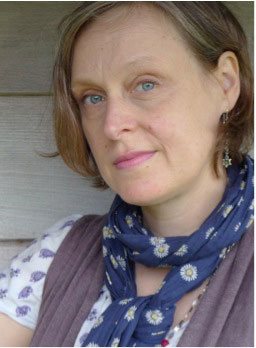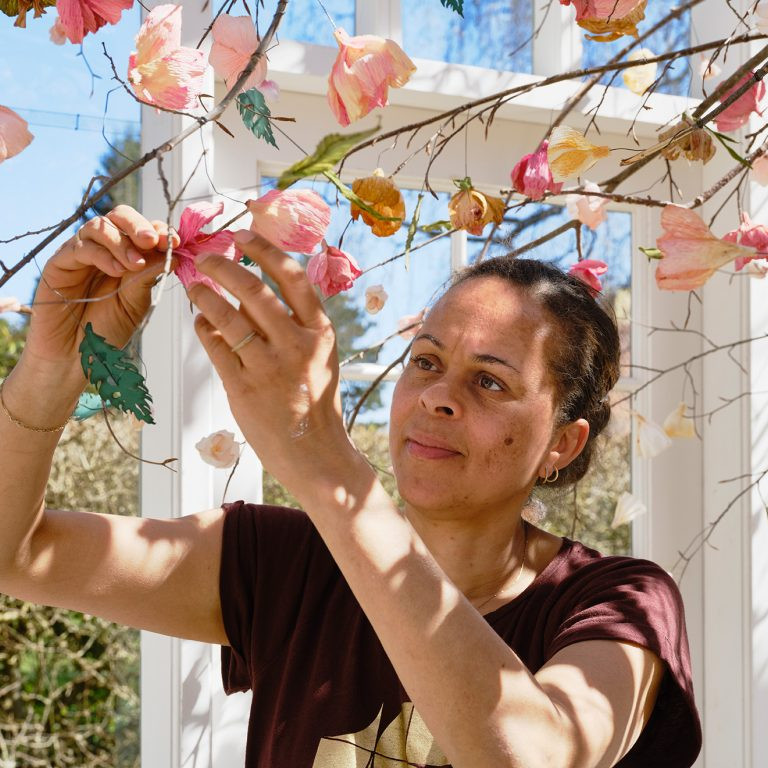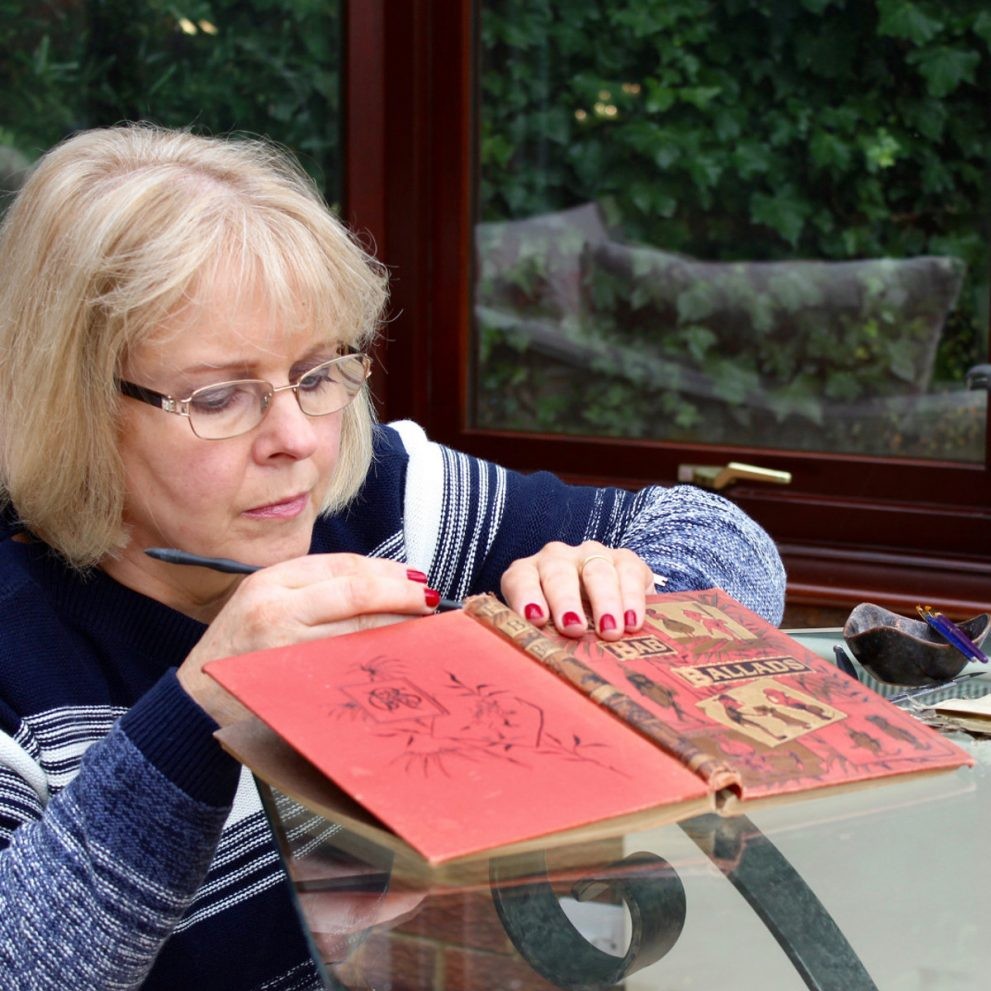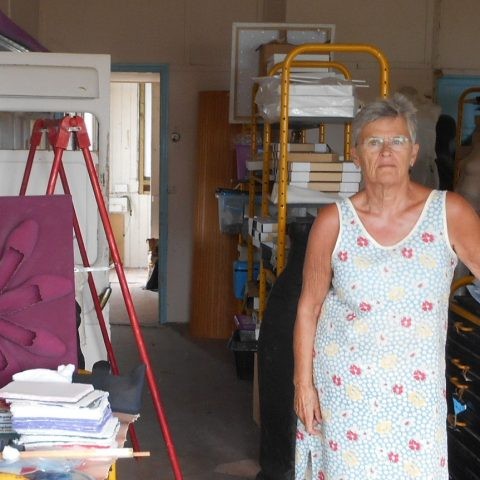Tracey Bush Paper Artist - UK
Can you explain entomology in relationship to your work?
I created scrapbooks for many years as a way of collating and editing my ever expanding collections of found papers: beer labels, music scores, fragments of letters, tickets, packaging. Whilst researching the idea of a collection in book form in I happened upon the idea to create a collection of books in the shape of butterflies and moths. It reconnected with my childhood interest in insects; I even had a pair of entomological forceps!
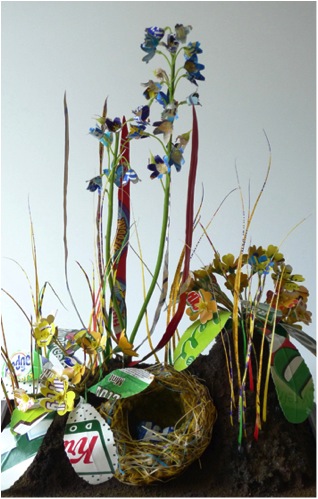
Nest and Eggs
You commenced your art career with a strong interest in natural history. Can you discuss this link?
From the age of 8 I drew flowers and insects. I wanted to be a natural history illustrator. When I began my studies at Art school I was guided into a different programme of study, but now have come full circle.
Please discuss your British butterflies.
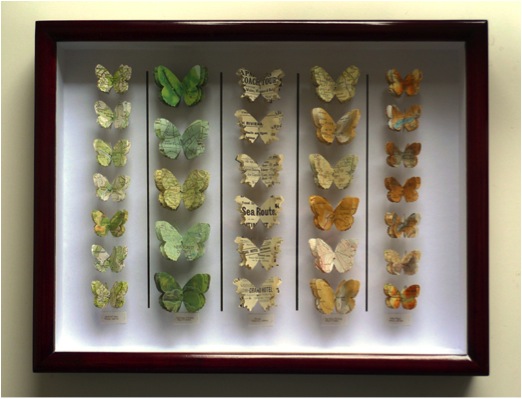
British Butterflies
Can you tell us about the different paper you use?
For British butterflies I usually use out of date maps and atlases of the British Isles. I enjoy working with both the range of colours: browns, greens, ochres and the evocative place names.
Discuss the different shapes of the butterflies and why you choose them?
The butterflies are all real species; the templates are cut actual size. When there are moth species called ‘The non-conformist’ and the drinker, there’s no need to make them up!
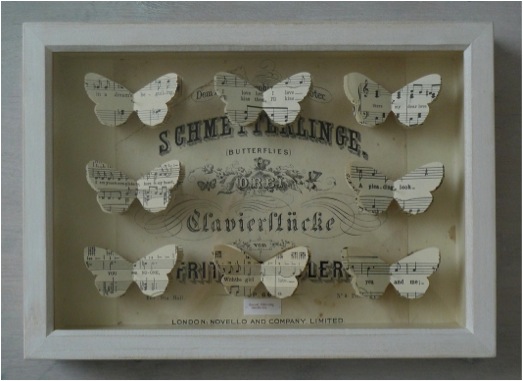
White Box
Discuss the link between the butterflies and paper?
There is always a link between the species’ common name and the material I use. For example, the moth ‘Beloved Underwing’ is made from vintage love song scores. The ‘Atlas Moth’ is made from an atlas title page.
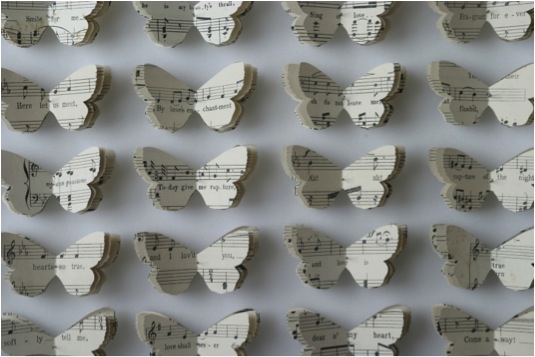
‘Beloved Underwing’
Explain your work with ‘Nine Wild Plants’ project and how it has propelled your art career?
In 2005 I was awarded an arts council funded exhibition opportunity by Craft Central, London which enabled me to spend more than a year researching, preparing and promoting the exhibition ‘Nine Wild Plants’ the impetus for the project began with reading that the average Western adult can identify less than 10 wild plants, but more than 1000 brands and logos. I collected responses to the question: which 9 wild plants could you identify and then collated the answers into a small artists book, the resulting ‘top 9’ plants were then used as the models for drawings with collage and 3D paper sculptures using branded paper packaging. The exhibition was featured in several publications, including Elle Decoration, Garageland, and Resurgence magazines. I had a really strong response to the exhibition, the Yale Centre for British Art acquired drawings form the show, and the work generated was also exhibited at Art Fairs, and curated exhibition: Precious, recycling in Art and Craft at the Hove Museum and Art Gallery (UK) Most recently the project was featured in the book: ‘Of Green Leaf, Bird and Flower’ published by the Yale Centre for British Art to accompany the exhibition (2014) of the same name. I am continuing to work with the herbarium format, although the plant species I am using have become wider than the original list of 9.
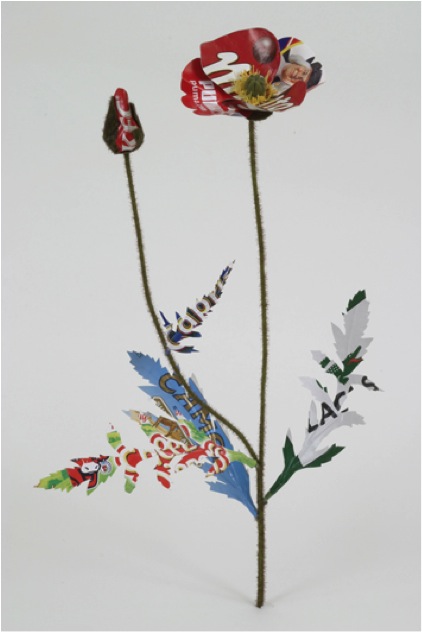
Poppy
After doing this project, can you discuss your own thoughts about the diminished knowledge we currently have on indigenous flora and fauna?
I’d like to say that I’m not making a criticism, just an observation. It simply reflects the culture we are immersed in.
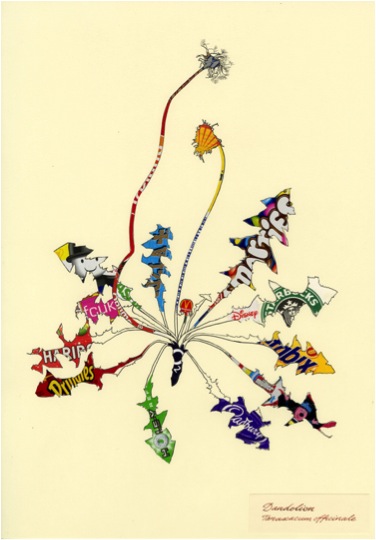
Dandelion
Have you considered doing a similar project here in the Southern Hemisphere with an Australian artist? “It would be interesting to see the results” – Deborah Blakeley.
It would be difficult for me as I’d not know the common names of any of the plants. It is an idea that could travel though.
Can you discuss, ‘The Little Clod of Earth’ from a technical aspect?
When making ‘The Little Clod of Earth’ (2008) I collected and pressed specimens of daisies, nettles and dandelions. I used these as models for the shapes of the leaves, sepals and petals. They are all handcut from paper and card packaging.
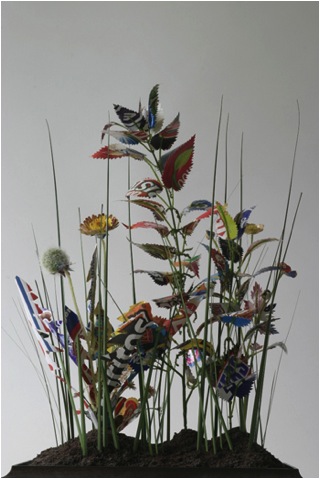
The Little Clod of Earth
The leaves and flowers are attached to fake plastic stems, and these are pushed into a solid sculpted Styrofoam base. The foam base is painted with pigments and fake soil. Everything you see is a construct! It was presented in a taxidermy case, and is now in a private collection.
Explain your use of taxidermy cases in your 3D work?
This links to Victorian conventions of collecting and displaying the natural world.
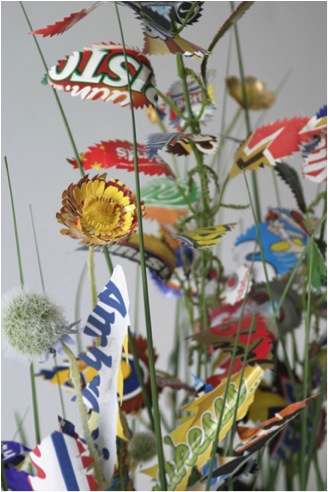
The Little Clod of Earth, Detail
You do commissions of butterflies using the paper provided by the commissioner. Discuss this part of your work?
Usually the paper is significant to the commissioner; maybe a wedding invitation or a fragment of a dress pattern. Most recently I was asked to make a butterfly collection by a NY knitwear designer, using her collection of vintage colourful knitting patterns> I found a species called ‘The Queen Cracker’ which clicks its wings when it flies, it reminded be if the click of knitting needles.
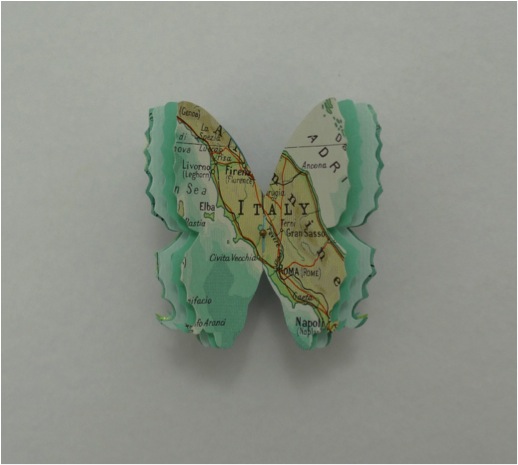
Map Butterfly
Discuss the installation of your work in the Members Room at the Natural History Museum?
The installation I made at the NHM London was called ‘The Ephemeral Imago’. It was a while back in 2002, and was the first time I exhibited my now signature butterfly box pieces.
You have a close relationship with the Natural History Museum. Can you expand on their commission in 2006 of 24 Butterfly Boxes?
In 2007 the Natural History Museum in London commissioned a set of 24 butterfly boxes for the development committee of the Darwin Centre 2. This was when the entomological collection wad ‘decanted’ into a new state of the art building. I was asked to create eco-friendly collections of butterflies and moths to be pinned in reclaimed entomology boxes. When working with the vintage cabinets I admired the skilled craftsmanship of the woodwork, but was glad I wasn’t squeamish, as I often found legs or insect parts from the previous occupants!
Expand on the importance of accuracy in your work? “Each butterfly is an actual species”?
By this I mean that I make templates from actual size species. The shape is authentic, although I edit the body, legs and antennae. If the species were made up I would feel that the butterflies were simply a decorative symbol, which is not my intention.
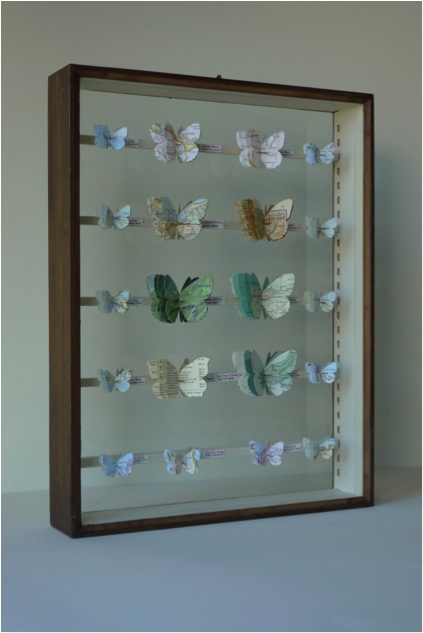
Dyffnyn Fernant
Why are butterflies such an important environmental indicator?
They are affected by climate change very quickly as they seem to move locale as the temperature rises. In Britain many species are becoming more northerly in range.
Can you discuss:
‘Two Moon Moths’
Indian Moon Moths Actias selene are the most frequently bred in captivity because they have a beautiful elegant shape, and are quite large. I have cut mine from a vintage map of the surface of the moon.
‘Beloved Underwing’
This species, Catocala ilia is also called ‘The Wife’. I cut these moths from vintage love song scores, and have fun rearranging the fragments of songs to create new meanings.
What work do you have in the Tate Gallery Library?
How has being in collections such as the Tate Gallery Library, the Museum of London and Jaffe Collection (Florida, USA) influenced your art status?
I have some artist’s books in the Tate Gallery Library and Archive. Being collected by the Yale Centre for British Art has significantly influenced my art status. My work is currently on display at Yale, in the exhibition ‘Of Green Leaf, Bird and Flower’, curated by Elisabeth R. Fairman. The exhibition is accompanied by a gorgeous catalogue, which takes its inspiration from an antique field guide.
‘Of Green Leaf, Bird and Flower’. Publisher: Yale University Press (23 May 2014)
ISBN-10: 0300204248
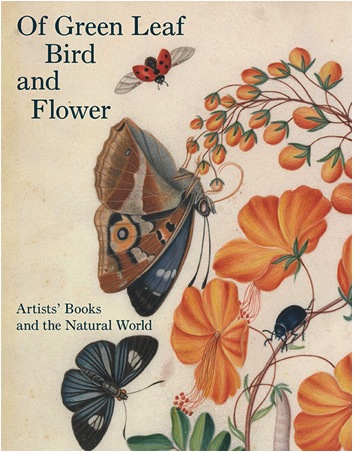
Please discuss a piece you are currently working on?
‘A Spoonful of Earth’ is a plastic takeaway spoon, which appears to have scooped up a tiny clod of earth. Amongst the daisy plants is a garden snail, its shell adorned with the Starbucks logo. My daughter had the inspired idea of using yellow glass seed beads for its eyes. I’d like to create an installation of ‘free range’ snails. It would be a fun way to fill a space.

‘A Spoonful of Earth’ (with Snail)
Contact details.
Tracey Bush
Alverstoke, Hampshire, UK
tracey@traceybush.com
www.traceybush.com
Tracey Bush, UK
Interview by Deborah Blakeley, August, 2014
Think a colleague or friend could benefit from this interview?
Knowledge is one of the biggest assets in any business. So why not forward this on to your friends and colleagues so they too can start taking advantage of the insightful information the artist has given?
Other artists you may be interested in:


